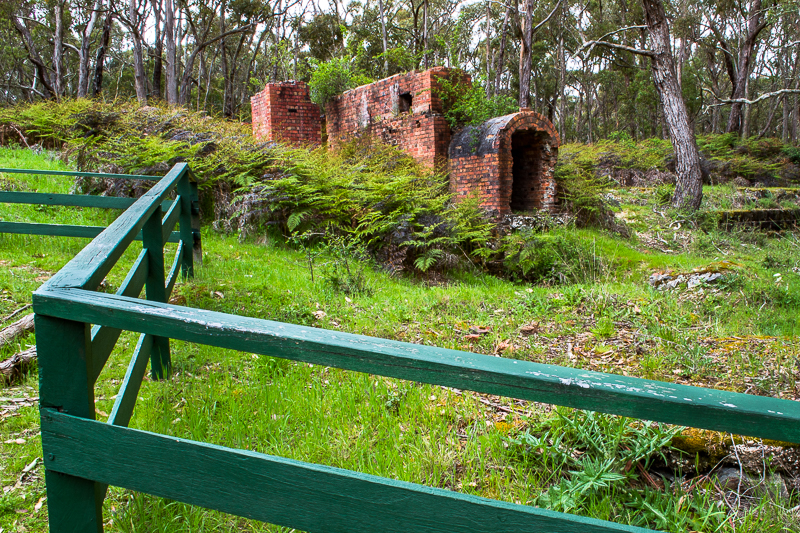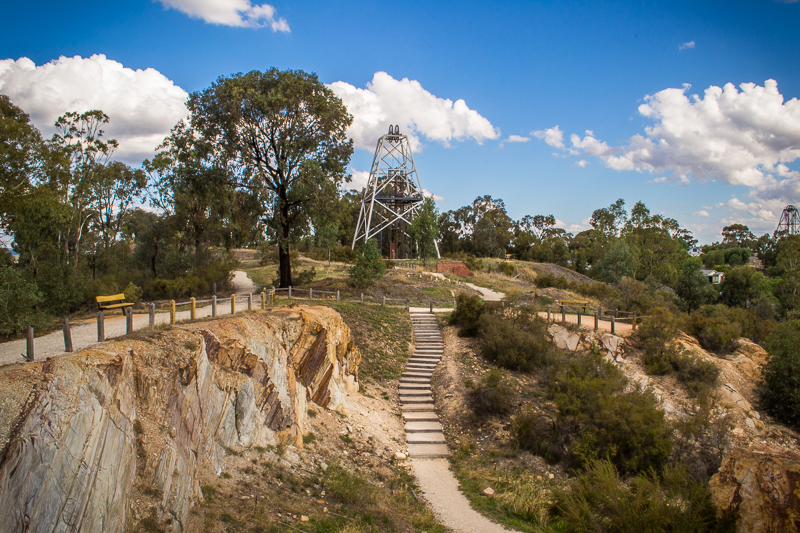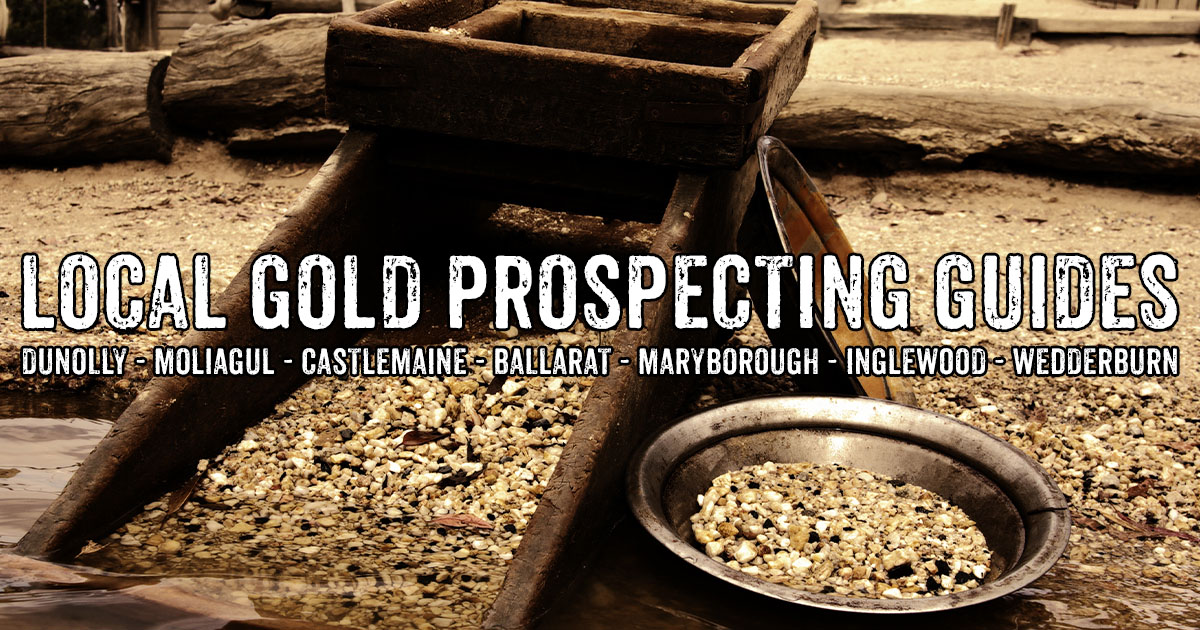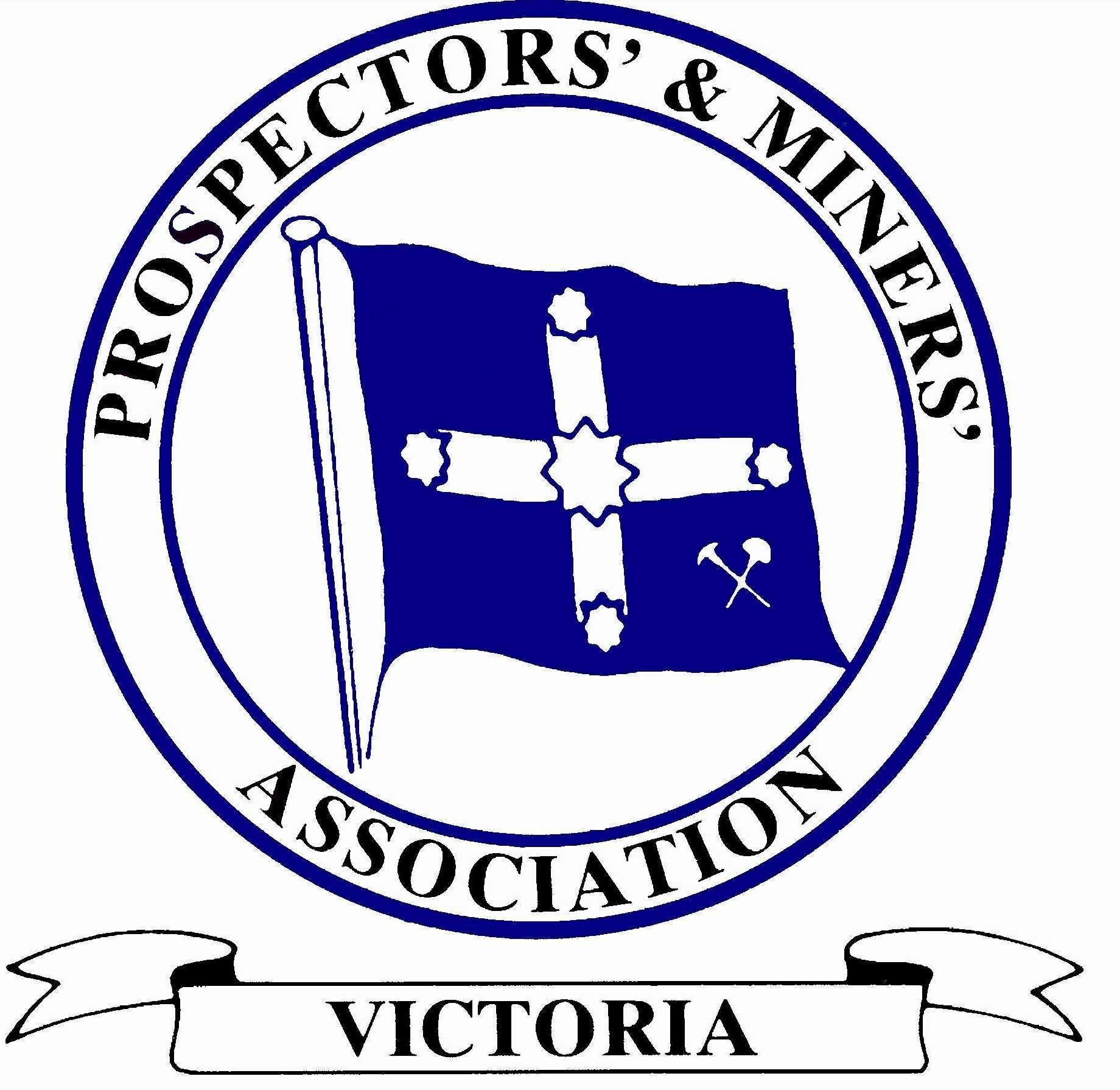
The Victorian Goldfields is filled with fascinating ruins and relics, where abandoned mines, diggings, boilers, machinery foundations and gold puddlers are scattered in abundance throughout the region.
I've gathered together this list of abandoned mine sites where you can safely explore and learn a bit about this remarkable aspect of our local heritage!
Please note that there are many deep open mine shafts remaining throughout the Victorian Goldfields.
Do not venture off the track or enter any mine tunnels you come across while exploring any of the region's many abandoned mine sites.
You can watch the video below, or keep scrolling if you prefer to read about these abandoned mines.
Jubilee Mine, Staffordshire Reef VIC

Jubilee Mine, Staffordshire Reef VIC
The extensive ruins of the Jubilee Company Quartz Gold Mine are a fascinating place to explore.
This significant site is nestled away within the beautiful forest of the Jubilee Historic Area, just half an hour from Ballarat.
A fantastic self-guided walk takes you around the site of the Jubilee Company Quartz Gold Mine. Features you will discover along the walk include battery foundations, engine beds, a water race, old mine shafts, surface workings, cyanide plant, tailings, old house sites and more.
Illustrated signposts provide lots of information along the way.
Garfield Water Wheel, Chewton VIC

Garfield Water Wheel, Chewton VIC
Visit the Garfield Water Wheel historical site in Chewton, Victoria and explore the ruins and remnants of the Garfield Company Mine.
The massive stone supports which still remain at the site once supported an enormous water wheel with a diameter of 22 metres.
Upon its construction the Garfield Water Wheel was hailed as the largest in the southern hemisphere! The water wheel was used between 1887 and 1903 to power the stamp battery for the mine.
Today visitors can explore many fascinating features of the Garfield Mine site by taking a short self-guided walk which travels around the area.
An information sign alongside the parking area provides a map and numbered features of the walking track. The supports for the water wheel itself are right alongside the car park and do not require any walking.
Alma Lead Cyanide Works, Bowenvale VIC

Alma Lead Cyanide Works, Bowenvale VIC
The Gladstone Bushland Reserve lies alongside Gladstone Road, Bowenvale and is home to the historic Alma Lead Cyanide Works.
This interesting mine site includes rows of cyanide vats, multiple dams, closed remains of shafts, and mullock heaps.
Red, White and Blue Mine, Muckleford VIC

Red, White and Blue Mine, Muckleford VIC
The Red, White and Blue Mine in the Muckleford State Forest is a fascinating place for a barbecue and bushwalk.
The historic mine is a sight to behold, with an intact poppet head, a mine shaft, machinery site, mullock heap and dams. The poppet head was originally from the Bendigo Deborah United Mine.
Forest Creek Historic Diggings, Castlemaine VIC

Forest Creek Historic Diggings, Castlemaine VIC
Bring a picnic lunch and take an easy stroll through the Forest Creek Historic Gold Diggings, exploring many fascinating historical features of this world-renowned alluvial goldfield.
At this site during the gold rush, miners sought to strike their fortune from the gravels of an ancient river bed - a former course of Forest Creek which formed millions of years ago.
Miners continued to work this site for gold well into the 20th century, with many interesting relics left for us to see today.
Grand Duke Mine, Timor VIC

Grand Duke Mine, Timor VIC
The Grand Duke mine site in Timor is a fascinating glimpse into the area's rich gold mining history.
Wander around the site and take a closer look at the impressive stone arch, which is all that remains of the pump house that used to remove water from this mine.
Boxing Reef Mine Shafts, Steiglitz VIC

Boxing Reef Mine Shafts, Steiglitz VIC
Three old mine shafts sit in a grassy field right in the middle of Steiglitz, surrounded by quaint picket fences and adding to the town's gorgeous historical charm!
Nineteenth century miners sunk these shafts three hundred feet underground to reach the prosperous Boxing Reef which runs alongside Regent Street.
Today the remains of these mine shafts make up part of the fascinating Steiglitz Town Walk. This is an easy half hour circuit filled with interesting ruins, relics and buildings of the gold rush era.
The walk begins around the corner at the Steiglitz Court House, and is an excellent way to explore this unique little town.
Central Nell Gwynne Poppet Head, Bendigo VIC

Central Nell Gwynne Poppet Head, Bendigo VIC
The poppet head of the Central Nell Gwynne mine is an iconic landmark in Bendigo, lying just down the road from the poppet head lookout at Victoria Hill.
The Central Nell Gwynne was the premier mine of Bendigo's 1930s mining revival, and is of high historical value due to the extensive and relatively intact features which remain at the site.
The impressive poppet head stands alongside a gravel parking area. Constructed of tubular steel, the poppet head has been restored and painted.
To the south of the poppet head there are concrete winding engine and compressor beds, and to the west you will find the concrete footings, floor and engine beds of a 20-head stamp battery.
Old Tom Mine, Whipstick VIC

Old Tom Mine, Whipstick VIC
The Old Tom Mine site lies within the Greater Bendigo National Park and is marked with a sign in the bush off Old Tom Road.
This spot is best reached either on foot from Eaglehawk-Neilborough Road or with a four wheel drive vehicle on the narrow and uneven dirt track which travels past the mine site.
A fenced section behind the 'Old Tom Mine' sign looks out over an open cut, and the area is filled with remnants of a range of mining activity.
An excellent and late (1930s) example of a gold puddler is located nearby as well as a water race and the remains of a battery site, cyanide plant, hydraulic sluicing and shallow alluvial workings.
New Australasian No 2 Gold Mine, Creswick VIC

New Australasian No 2 Gold Mine, Creswick VIC
The New Australasian No. 2 Deep Lead Gold Mine in Creswick is the scene of one of Australia's worst underground mining disasters!
On the 11th of December 1882 forty one men entered the New Australasian No 2 mine to work a seemingly ordinary Monday night shift. In the early hours of Tuesday morning, 12th of December 1882, water flooded the mine from the old workings of Australasian No. 1 trapping twenty seven of the men underground.
Rescue efforts commenced immediately but by the time the miners were reached three days later only five had survived. The body of one man was still warm when it was recovered.
Beehive Mine, Maldon VIC

Beehive Mine, Maldon VIC
The thirty metre high Beehive Mine Chimney is an iconic part of the Maldon skyline.
Completed in 1863, it's the only chimney of its age and size remaining in Victoria! Visitors can stroll through the mine site of the Beehive Gold Company and take a close look at the chimney and a fenced mine shaft.
Alongside the chimney are the fascinating remains of the brick and stone substructures for the boilers and steam engine that powered the mine.
North British Mine and Quartz Kilns, Maldon VIC

Take a self guided tour to explore the fascinating and extensive ruins of the North British Mine and Quartz Kilns in Maldon.
The walk showcases the mine's machinery foundations, cyanide plant, large mine shaft, and well-preserved quartz kilns.
Seen as a feature of Maldon's mining history, quartz kilns were used to roast quartz in preparation for crushing as it burnt off impurities and made the rock more brittle.
The kilns at the North British Mine site are an excellent example of early mining techniques in Maldon, and are some of the best surviving quartz kilns in Victoria.
Mt Tarrengower Tunnelling Company, Maldon VIC

Mt Tarrengower Tunnelling Company, Maldon VIC
The Mount Tarrengower Tunnelling Company commenced work in Maldon in 1865, and were the first company in Australia to use compressed air-driven rock drilling technology. Subsequent widespread adoption of this technology was a milestone in Australian underground mining.
After failing to find payable gold, the company was wound up in 1870.
There is a short walking track to the Mount Tarrengower Tunnelling Company's mine, beginning from Anzac Hill Road.
Battery Dam and Distillery, near Maryborough VIC

Battery Dam and Distillery, near Maryborough VIC
The Battery Dam Historic Site is located just outside Maryborough in the Craigie State Forest.
The area was used during the gold rush to crush and process quartz from mines in the area. After gold processing operations ceased, some of the equipment was adapted to be used for a eucalyptus distillery.
Today it features a picnic area, walking tracks, gold processing and eucalyptus distillery relics, and beautifully illustrated information signs.
Features include a stamp battery site (the battery no longer present), Cornish boilers, cyanide vats, gold puddler, and hut ruins.
Tunnel Hill Mine, Talbot VIC

Tunnel Hill Mine, Talbot VIC
The Tunnel Hill Mine lies within the Tunnel Hill Bushland Reserve just outside Talbot, and features an abandoned tunnel running in a straight line beneath a small hill.
There are entrances on both sides of the hill. The mine is locked with gates, but you can get a great view down the tunnel.
The Tunnel Hill Bushland Reserve is a good spot for gold prospecting and bushwalking.
Pink Cliffs Geological Reserve, Heathcote VIC

Pink Cliffs Geological Reserve, Heathcote VIC
The Pink Cliffs Geological Reserve is a remarkable area on the edge of Heathcote. Once a hydraulic sluicing site, mining activity in the late 19th century washed away the top layer of earth and revealed the dramatic, colourful cliffs on display today.
Hydraulic sluicing at this site was carried out in the 1870's - 80's under the direction of James Hedley, a pioneer in the development of sluicing and dredging in Victoria.
A track takes you on an educational circuit walk, showcasing the stunning geological features of the Pink Cliffs Geological Reserve as well as providing information signs and lookout points along the way.
The walk is well signed and directs visitors to both a lower lookout and upper lookout over the stunning pink cliffs, which are located at the back of the reserve.
Eureka Reef, Chewton VIC

Eureka Reef, Chewton VIC
Take a walk around the Eureka Reef Gold Mining Precinct and discover the fascinating ruins and features which remain from a century of gold mining operations!
Once a busy mining village, today Eureka contains some of the oldest quartz mining relics in Victoria, as well as remnants of houses, batteries, alluvial mining, cyanide treatment, and more.
Porcupine Flat Gold Dredge and Dragline, Maldon VIC

Porcupine Flat Gold Dredge and Dragline, Maldon VIC
The Porcupine Flat gold dredge and dragline is a fascinating road-side relic just outside Maldon.
Visitors can get a close look at these massive old mining machines, and a small picnic area with a table and fire pit makes this a great place to stop in for a picnic lunch.
Deborah Company Historic Area, Bendigo VIC

Deborah Company Historic Area, Bendigo VIC
Visit the Deborah Company Historic Area and explore the ruins and remnants of one of Bendigo's most successful gold mines of the 1930s-40s.
A steel poppet head, concrete engine beds, and foundations of a twenty-head stamp battery remain at the site.
A shed containing a five-head stamp battery was relocated to this site in the mid 90s, having previously served as the Golden Square State Battery. The shed has an open front covered with steel mesh, so visitors can get a close look at the stamp battery inside.
Victoria Hill Mining Reserve, Bendigo VIC

Victoria Hill Mining Reserve, Bendigo VIC
Take a walk through the extensive Victoria Hill Mining Reserve and explore the site of Victoria's deepest gold mine.
Walking tracks take you on a journey through the area, taking you past fascinating ruins and relics. Lots of detailed information signs provide the site's history along the way.
In the year 1908, the Victoria Quartz Co Mine had the world's deepest shaft at 1,365 metres. By 1910 the shaft had reached a depth of 1,406 metres!
Many successful mines operated at Victoria Hill, one of the richest areas in the Bendigo goldfield.
A huge poppet head has been converted into a lookout platform, a dominant feature of the reserve.
Carefully climb the steps to the lookout and take in the beautiful views over Bendigo. See how many other poppet heads you can spot around the town!
SEE ALSO

- General guide to gold prospecting in the Victorian Goldfields
- Ballarat gold prospecting guide
- Castlemaine gold prospecting guide
- Maryborough gold prospecting guide
- Dunolly and Moliagul gold prospecting guide
- Inglewood and Wedderburn gold prospecting guide
Handy gold prospecting information
- Puddling machines of the Victorian Goldfields
- Surfacing in the Victorian Goldfields
- Dangers of mine shafts in the Victorian Goldfields
- Diaries and memoirs from the Victorian gold rush
- Gold history locations on Goldfields Guide


